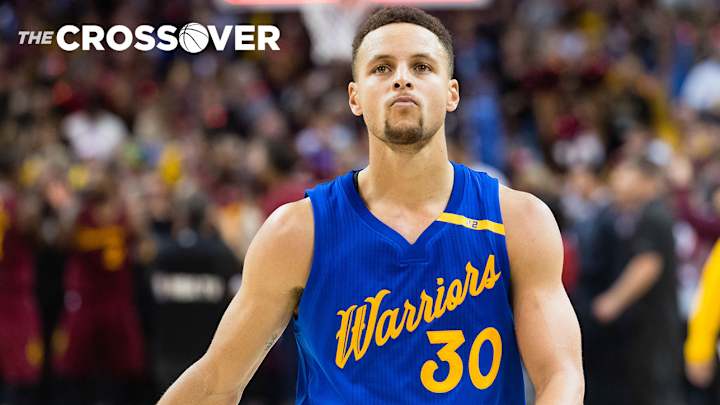Steph Curry Hasn't Been Himself

A juggernaut offense, a co-headlining superstar, and a sterling record have overshadowed the fact that we’ve yet to see Stephen Curry at the height of his powers this season. There is more than mere deference in play. What made Curry’s play so unique—and so uniquely dangerous—last season was his accuracy on quick fires from untold depths, shots that a defense could never hope take away. Defensive schemes are useless at 27 feet. There is no help. Pressure can be so easily burned with a sharp crossover or sudden screen. Yet defenders had no choice but to check Curry as high on the floor as they could, for fear of the game-bending threes that the unanimous MVP had casually made a standard part of his game.
Curry still demands close defensive attention and is still shooting well overall by most conventional standards. His pull-up game, however, has waned and not yet recovered. The very threat that transformed Curry is made empty by his shooting just 28.5% on pull-up three-pointers this season, per NBA.com—some 14 percentage points worse than last season. Shots like this now seem like a genuine rarity:
Curry deservedly still gets the full respect of opposing defense helps, and nothing in the data suggests it wise to give Curry daylight, even if his self-created shot has been uncharacteristically off. But the idea of that threat is a poor substitute for a real, in-game reminder. It was only after Curry hit a few impossible pull-up threes last season that the defense in front of the Warriors began to dissolve. Desperate double-teams created other openings. Dramatic overreaction allowed Klay Thompson to sneak about undetected. Traps and hard hedges activated Draymond Green as a playmaker, creating a hyper-skilled midpoint for the offense.
Golden State still taps into all of those elements, albeit in slightly different ways—many of which are now rooted in Kevin Durant’s ability to handle and create. If this season’s Warriors have felt perilously dependent on Durant at times, it’s because they are. All the apparent balance in having three 20-point scorers on the same team is mitigated when Curry isn’t connecting on his pull-up jumpers nor maintaining any kind of consistent pick-and-roll presence. Among those who have attempted more shots per game out of the pick-and-roll than Curry this season: Rajon Rondo, Tyler Johnson, Beno Udrih, Jameer Nelson, and Sergio Rodriguez. A high screen for Curry once seemed like an unguardable premise. Now it’s only an occasional piece for the Warriors, who have diversified their offense but lost a keen edge in the process.
What makes Curry’s odd performance so difficult to place is how little, in the broadest sense, it has seemed to matter. Whether Curry plays up to his personal standards is largely irrelevant when his mere combination with Durant, Thompson, and Green make for a preposterous cover. The Warriors are scoring even more efficiently than they did in their 73-win season and outscoring opponents by slightly more overall. They have won 14 of their last 16 games, 26 of their last 29, and are currently on pace to top 70 wins again. In some ways, the quirks of their play should be beyond reproach. But if the 2015-16 Warriors taught us anything, it’s that these small curiosities can be fraught with meaning in the wrong matchup.
That won’t mean much to the Nuggets and Mavs of the NBA world, who can only make something of a game against the Warriors before losing out to scoring attrition. Beating an opponent like Cleveland, on the other hand, will require a certain maneuverability to Golden State’s operations. The Cavs were able to turn the Finals by adjusting LeBron James’s defensive assignment, tightening their coverage overall, and playing into the fact that Curry was unable to create separation off a sprained knee. Mitigating even choice elements of Curry’s game slowed the Warriors enough to make a difference. Durant changes everything. The very fact that Cleveland would now have to choose between matching up LeBron James with one of Durant or Green creates an opening, but so much still hinges on the idea that Curry would be able to punish switches by working his way into makeable shots. That range of looks can mean something different for Curry than for any other player in the league, provided he’s able to tap back into that vicious pull-up game.
What's Driving The NBA's 50-Point Boom?
With most elements unchanged, the Warriors are probably still dynamic and explosive enough to win the title. In a way, Curry’s errant pull-up shooting even makes Golden State’s offense—currently the best in NBA history—all the more terrifying by its absence. The high-water marks of the most dominant team in the league have been set with the best player in the NBA last season operating in middle gears. Durant has been sensational. Green delivers nightly. Thompson has regressed as hard to the mean as expected from his early shooting woes. Golden State is getting everything necessary of Ian Clark and David West, sorting out how to manage Zaza Pachulia and JaVale McGee, and pacing Andre Iguodala and Shaun Livingston as much as possible for a long season. So much is in place but last season’s centerpiece, whose game is obviously effective but still somewhat askew.
Should Curry’s pull-up shooting perk up, Golden State will only extend its lead in offensive efficiency on the whole of the NBA record. Anything less, however, could force Golden State to eventually confront the fundamental differences of a reoriented Curry.

Rob Mahoney is an NBA writer dedicated to the minutiae of the game of basketball, its overarching themes and everything in between. He joined the Sports Illustrated staff in 2012.